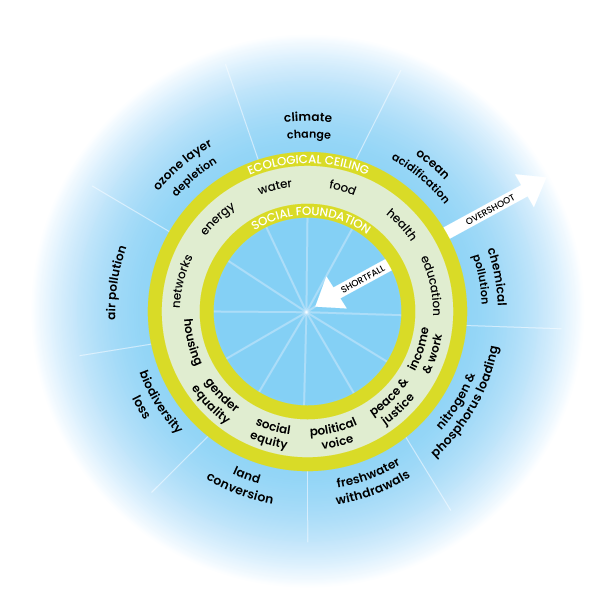What is doughnut economics? – the balance between social foundation and ecological ceiling


Doughnut economics is a visual framework model created by Oxford Economist Kate Raworth in her book “Doughnut Economics: Seven Ways to think like a 21st-century economist” (Raworth, 2017). Its aim is to create a beneficial and realistic regenerative economy.
The diagram was first published in 2012 in her research article “A Safe and Just Space for Humanity” (Raworth, 2012). Its shape, with a hole in the middle, gave birth to its name.
The main goal of the model is to re-frame economic problems and set a sustainability model that is split into three different areas:
1. Social foundation
2. The safe and just space for humanity
3. Ecological ceiling
The center of the doughnut is associated with the ‘social foundation ‘, a concept inspired by the Sustainable Development Goals of the United Nations. These goals represent the basic human needs and aim to ensure that no one falls short on life’s essentials.
The outer ring of the visual scheme is designed based on the Planetary boundaries (Richardson et al., 2023) and represents the climate boundaries humanity must not exceed, of which six have already been transgressed. Pressure is also increasing on all of them except ozone depletion.
A balance between the inner and outer ring is where it is argued that there is a safe and just space for humanity that we should all pursue for a prosperous future. This is where well-being resides for both humanity and the planet.
A shortfall or an overshoot means unbalancing our existing relationship with the environment that surrounds us, which can lead to irreversible damage to humanity. Social boundaries should be combined with planetary boundaries, and there is a need for evolution from previous economic models. We should embrace the premise that the 21st-century challenge is to meet the needs of all within the planet’s means.
References
1| Raworth, K. (2012). A safe and just space for humanity: can we live within the doughnut?. Oxfam.
2| Raworth, K. (2017). A Doughnut for the Anthropocene: humanity’s compass in the 21st century. The Lancet Planetary Health, 1(2), e48–e49. https://doi.org/10.1016/s2542-5196(17)30028-1
3| Richardson, K., Steffen, W., Lucht, W., Bendtsen, J., Cornell, S. E., Donges, J. F., Drüke, M., Fetzer, I., Bala, G., Von Bloh, W., Feulner, G., Fiedler, S., Gerten, D., Gleeson, T., Hofmann, M., Huiskamp, W., Kummu, M., Mohan, C., Nogués-Bravo, D., . . . Rockström, J. (2023). Earth beyond six of nine planetary boundaries. Science Advances, 9(37). https://doi.org/10.1126/sciadv.adh2458
About Susplus
Susplus is offering a simple, intuitive, and innovative data-driven platform service that supports companies of all sizes to accelerate their path transition to carbon neutrality. We empower companies to start and accelerate their carbon neutrality transition process by measuring and improving their business ecosystem value-chain impact. Susplus platform’s innovative features and intuitive design, will lead you during the transition journey by helping your team to measure carbon emissions in your business value-chain, create action-plans to easily reduce them, and report confidently in compliance with the latest reporting standards. Learn more at susplus.tech, on Linkedin, and on X @susplustech